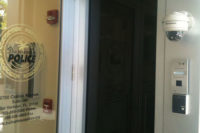Donald Trump isn’t the only one with borders on his mind. World events in recent years have demonstrated that the need for physical security doesn’t start at the front door of the office. With increasing incidents of vehicle attacks and terrorism both inside and outside buildings, more and more companies are realizing that stopping potential bad actors farther from the door is not only desirable — it is necessary.
“There is more emphasis on stopping the bad guys at the perimeter,” says Jack DeMao, CEO, Electric Guard Dog, Columbia, S.C. (SDM’s 2016 Dealer of the Year). “Top level customers historically would try to protect the facility itself. Now there is more emphasis on stopping them at the border.”
John Cassise, senior product manager, Tyco Security Products, Westford, Mass., has seen this trend, as well. “In general they want to vet the person, to provide the first level of access farther away from their secure assets and the main parts of the facility,” he says.
As customers seek to move their access control systems outside, they also want to bring the integration they enjoy at their facility to the perimeter.
“They want integration of multiple security systems with access control,” DeMao says. “Everybody wants everything tied in and operating from one device.” Or, increasingly, they want to centralize control, he adds. “The biggest trend for us in 2016 was the number of customers asking me to set up access control from a central location where they want to run gates from their headquarters.” In some cases these were in separate states, he says.
Perimeter security often involves vehicles, whether it is parking control or preventing weaponized vehicles, says Greg Hamm, vice president, sales and marketing, Delta Scientific, Palmdale, Calif. “It is self-evident that the world of physical security has changed in response to the pervasive threat of terrorism around the globe,” he says. “The trend that has catapulted to the top of the list for vehicle perimeter security is securing temporary events with certified crash equipment that can be towed away when the occasion is over. At the very apex of this trend is providing a means to defend against vehicles being used as weapons, as has happened recently in London as well as Nice, Berlin, Columbus, Ohio, and New Orleans.”
Beyond the usual parking control or perimeter security of facilities, there is also a growing trend to electronically secure areas that have not been possible previously. The advent of more wireless, solar and other new technologies are making it easier and more affordable to secure remote and unguarded facilities, says Keith Jentoft, integration team, Videofied, a Honeywell Security and Fire company, Melville, N.Y. “Electrical substations, construction sites, fenced yards, these sites have been difficult to secure as there is often no Internet or power. New battery-powered wireless solutions now make this a viable target for installations and revenue.”
But whether it is an existing customer that wants to push the perimeter outward or a previously unsecured site that can now take advantage of newer solutions, there are definitely things an integrator needs to understand about working outside the building in order to take maximum advantage of these business opportunities.
KNOW BEFORE YOU GO OUTSIDE
Ask any contractor or installer and they will tell you working outside is hard. Not only do you have the elements to contend with, but things that work with ease inside the building may prove challenging once you step outdoors.
“As a company that does outdoor security, we have always felt we do the harder job, because our environment is harder,” DeMao says. “Inside security is more controlled. When the customer comes outside, they are trying to bring all their control devices with them. They are used to having easy systems, to turning their security on and off with their iPhone. They want their electric gate to be integrated into that and it is not as easy.”
What the customer wants can almost always be done — for a cost. The price of trenching or adding external power can be prohibitive. “Inside you have ready power and networks,” DeMao says. “Outside those may not be as reliable.”
Power is probably the No. 1 issue integrators might face, DeMao says. Often the customer may overestimate the power or network availability on the site. “A customer will say they have power to that location, but every time it rains, that link goes down,” he says. “The biggest thing to be aware of is the customer’s alleged infrastructure. Maybe they used to have power but don’t anymore. They have a telephone line, but it is ancient copper and very unreliable. They aren’t lying to us; they just don’t know.”
DeMao says they always put their own solar power and cable network in to make sure everything works correctly.
Perimeter security often involves fences and gates, which can come with their own unique challenges — in fact, traditional security integrators frequently contract-out gate control work for that reason.
“Fence line detection and solar-powered data transfer devices require a level of ‘best practices’ protocol to ensure proper design and application for reliability,” says Kerby Lecka, director of marketing, Security Door Controls, Camarillo, Calif. “Some pitfalls include line-of-site data transfer, distances and optics.”
DeMao agrees. “If you have an electric gate motor now 2,000 feet from your building it can be hard to get that signal back … and there can be issues with obstruction.”
Don’t forget to consider the user and throughput, adds Curtis Dennis, senior technical design lead for the U.S. & Canada, Nedap Identification Systems, Branson, Mo. “The consideration of throughput rates, security levels and needs, as well as operational needs, vehicle types, guaranteed uptime needs, budget, etc., are all important,” he says. “Also, consider user needs such as hands-free access, high-speed vehicle access, vehicle types, fleet management protocols, etc.”
It is important to really talk to the customer about their expectations, DeMao says. “It is fundamental to work really hard to understand the customer’s operation and how they intend to use the system. Most of my customers believe the way they operate is standard for their industry and that is just not true. Many times the people buying the perimeter access system might not know the details of how their facility works outside. Do they need access at night or on weekends? They might say no because they don’t know that trucks come in from California at 2 a.m. That is a major area of mistakes.”
Finally, the most obvious difference in outside versus inside equipment is that it has to stand up to the elements. Beyond making sure you use outdoor-rated equipment or housings, DeMao adds that there is another element to consider. “Anticipate more damage. When you are outside, no one is watching how people behave as much. It can be vandalism, but often it is just sloppiness. Take a trucking terminal. Drivers of 18-wheelers are not Swiss watchmakers. We make our poles to be run over. No matter what kind of bollard you put there they will back into it or knock it down, so we build a base and have a breakaway pole that can be easily replaced.”
OPPORTUNITY AT THE GATE
While outside work was traditionally the purview of those specializing in that area, advances in wireless, cellular, solar and mobile technologies have brought more options to the market overall, and more security integrators are looking to go after that work themselves now that it is easier to do.
“Integration of access control devices and functionality via wireless data transfer … allows the quick and easy addition of access control to perimeter areas without having to hardwire connections back to a central station or network,” Lecka says.
“Honeywell’s Videofied has battery-operated cameras and battery-powered badge readers,” Jentoft says. “This, combined with battery-powered control panels and a cell model creates a completely wireless access control solution with video verification — with absolutely no infrastructure except a cell signal…. The main impact is a major expansion of potential applications and customers. The only requirement is a cell signal. No Ethernet, no power, no problem. This means that any remote asset or fenced gate is a potential source of revenue.”
Dennis adds, “There have been improvements in sensing and credentialing technology, i.e., better cameras, faster biometrics, and the ability to boost smart cards for long-range reads. Lower power consumption equipment makes for easier installs. There are lower price points on equipment.”
Long-range access transmitters from Farpointe, Sunnyvale, Calif., can now add 13.56 MHz contactless smartcard modules with MIFARE Classic or DESFire EV1 to be compatible with the company’s contactless smartcard readers and credentials, says Scott Lindley, president. (See “Cybersecurity Concerns,” page 102.)
Wireless is a key technology for perimeter access, says Paul Accardo, a representative of LiftMaster, Oak Brook, Ill. “With moving the perimeter farther away from the building, wireless keypads are ideal, eliminating the need to run wires and featuring advanced radio technology, which virtually eliminates interference and offers extended range.”
DeMao agrees. “Wireless is where it has to go. We can wire everything outside, but it is expensive. And it is very disruptive to the customer’s business. In our case, because we have always had solar, that is how we grew up, so we can get around power problems.”
The combination of these and other new technology options and interest in higher perimeter security means there are many new avenues opening up for security integrators, Hamm says. “Originally [barriers] were used at high-profile political or governmental locales such as conventions, inaugurations and embassy protection,” he says. “They are now being used in places such as Mardi Gras where many people temporarily congregate and must be protected from vehicles.
“There are certain industries that are at the forefront for terrorist attacks and need to be protected more heavily. These provide the best sales targets for dealers and integrators.” He cites petrochemical and refiners, storage areas, distribution centers, treatment plants, dams and other utilities as some of the best opportunities.”
Specialty Access Systems, Camarillo, Calif., an SDC integrator, recently installed a complete system for a food processing facility, Lecka says. “This solar-powered facility used cameras, gates, door and access control solutions to limit access to prevent food contamination and provide for continuous improvement of their food manufacturing program,” he describes.
Tyco recently introduced mobile security that eliminates some of the cost and issues with traditional perimeter security, particularly for temporary or mustering sites, Cassise says. “One trend we are seeing is the ability to have mobile devices that can be used by security officers to stop anyone and vet their credentials.”
The Go Reader can be used in temporary areas, perimeters, offsite events, construction, or mustering situations, says Rick Focke, senior product manager, Software House, Tyco Security Products, Westford, Mass. “It operates in offline mode, too, so if you can’t get the network out there or it is too slow, this is a solution you can take off the grid and still operate,” Focke explains.
Cassise advises integrators to start thinking about the perimeter being much farther away from the lobby and the door. “Look at how to provide for your customers and how these new technologies let them expand their perimeter much farther. Some of these technologies cost less but have the same complexity to them and can enhance customer security significantly.”
He also suggests other technologies that can enhance the perimeter such as faster biometrics with turnstiles, and the use of Bluetooth technology.
“Companies that previously didn’t manage their parking lots because of cost, now have a solution where they can have a guard using this,” Cassise adds. It lets them move their perimeter farther out than they ever thought they could for a lot less cost and complexity.
“The point is to look for valuable assets/facilities where it is worth paying for protection,” Jentoft says. “There must be access worth controlling. While most of the doors/entries in traditional buildings have been considered, remote assets and facilities remain an untapped market.
Cybersecurity Concerns
One thing that may not be as obvious about perimeter access control is the potential threat of hacking or reader security concerns. Often these readers are out of sight of the main building or in remote areas. While they are physically hardened, cyber-hardening is another thing entirely.
“Because we are moving things out to the perimeter [it is important] to use a credential that is more secure,” says Tyco’s John Cassise. “That means moving away from proximity to DESFire or EV1 and other credentials that can be interrogated. Once you start pushing that reader farther away from the secure area, the less control you have over it. Using Wiegand from reader to panel becomes the weak link.”
Farpointe’s Scott Lindley agrees. “Wiegand is the industry-standard protocol commonly used to communicate credential data from an access control care reader to an electronic access control panel. However, Wiegand itself is no longer considered inherently secure due to its obscure and non-standard nature.
“To be useful in today’s long-range access systems, cybersecurity measures must be paramount. For example, using longer customer Wiegand formats, such as a 34- or 36-bit format, the long-range system can be made more secure.”
Other options include using the smartcard formats, which Farpointe now offers as well, or a long-range transceiver/receiver solution that only communicates when actively pressed by the user, reducing the time it could be intercepted.
“A card could activate more than one device at a time, versus the transmitter, which selects exactly the mechanism to be immediately triggered,” Lindley explains.
Understanding the New Gate Safety Standards
UL updated its safety standards for automatic gates, known as UL 325, in 2016. The standards require that in addition to safety devices such as photo eyes and/or sensing edges, gate operators bearing the UL label must stop working if the safety devices are not functioning properly. As a result, many manufacturers have updated entire product lines to meet and exceed these safety standards.
There are three things security professionals should understand about the latest changes to gate safety:
1. Be compliant. Gate operators manufactured beginning in 2016 need to meet the new UL 325 Safety Standards. If the automatic gates in your client’s property or community do not have the proper safety equipment, consider asking a professional installer to add the proper safety entrapment protection or to replace them with the latest models and safety entrapment protection devices.
2. Make sure installation and maintenance are performed by professionals. It is recommended that automatic gates and access systems should be professionally installed by a safety-trained dealer and inspected regularly. Work with a professional to ensure that your gate access systems are designed, installed and maintained in accordance with UL 325 and ASTM F2200 Safety Standards.
3. Maximize safety and security. Gate operators should also feature a battery backup system, so the gate will continue to operate properly in all conditions, even when the power is out. Internet connectivity is also an important way to increase security. This allows both residents and association managers to monitor and control gates remotely through a smartphone app. — Contributed by Pat Evans, marketing manager, perimeter access solutions, LiftMaster.
MORE ONLINE
For more on parking and perimeter solutions visit SDM’s website, where you will find the following articles:
“The Pros Discuss Parking & Gate Control”
www.SDMmag.com/the-pros-discuss-parking-gate-controls
“Choosing, Designing & Installing Parking and Gate Systems”
www.SDMmag.com/choosing-designing-and-installing-parking-and-gate-systems
“Parking & Gate Best Practices”
www.SDMmag.com/parking-gate-best-practices







